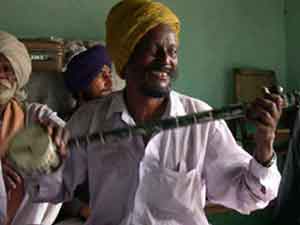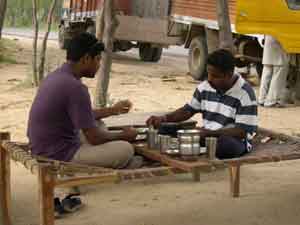   
Get 3 songs FREE
Become
a member Details
Hindi Font
Many pages of this site use a Hindi font. If you don't have it installed on your computer - click here. |
|
| Travel
Experiences of "Beat of India" |
|
POSTCARDS by Vrinda Manglik
(Vrinda Manglik is an American student. She spent one month in India, July 2004 on an internship with Beat of India, one week of which was spent in Punjab shooting & recording with the team.)
Just over a week ago, five Indians of five different mother tongues set sail in a small white car towards Punjab, the land of five rivers. With a plethora of video and sound equipment packed in the trunk, a Hindi map of Punjab, and a vague list of names and mysterious locations like "near the bus stop" in hand, we were off to find authentic folk music in the breadbasket of India.
We tumbled over many dirt roads to get to the villages, taking leads from various professors and asking dozens of roadside wanderers to point us in the right direction. At each village we were greeted with open arms. Each village provided me with several special moments, postcards of my trip with Beat of India.

[Postcard #1] We are sitting in the dark, outside a single-room hut in the remote village of Manakpur Sharief. Through the darkness, I can make out the expressive wide eyes of Pala the algoza-player, and his never-ceasing broken-toothed smile. He wears a black and white striped turban. Rice paddies surround the village, and the humidity holds us. A woman with her head covered brings us first water, then tea with milk and sugar in steel cups. All that exists is this place, with its piles of hay and bricks, adobe huts and cows and chickens. A woman with a yellow chunri gathers firewood. A lone bird flies overhead, and a young girl stands on the rooftop of a hut, pointing out stars to the baby on her hip. The village gathers around us. Curious adults (who have maintained the innocent, trusting eyes of childhood) look on. We speak to Pala about his life and his music. We tell him about Beat of India, and how we want to help folk artists in creating awareness and availability of their music. He is clearly excited. He is eager to perform, to gather his accompanists, and do this in the best manner possible. And of course he is very happy to have visitors who have sought him out, and who want to listen to his music. We finalize the details of when we will hold the recording session.
We zigzagged across the state in the car, alongside cyclists in turbans and many herds of cattle, through a dusty haze, beneath an unrelenting sun. We covered over a hundred kilometers from Chandhigarh to Ropar, to Patiala, to Ludhiana, to Amritsar, with spontaneous outbursts of singing and clapping the likes of 'Mast Qalander'.
I gazed out the window, hardly believing that all this was real, and not simply out of a magazine. Rice paddies, mountains, bullock carts, and colorful people in colorful clothes. Small children in school uniforms carrying tiffin pails; walls with Punjabi lettering in blue, green, red, and yellow; rickshaws; brick barns; tall haystacks; cattle festivals; market places; temples; mosques; and rubbish piles. I was constantly in a trance.
[Postcard #2] Our trip was punctuated consistently with meals at roadside dhabas. Towards the end of the trip, we were less energetic but still a jolly bunch, and we greeted these scattered meccas bleary-eyed, sweaty, and bug-bitten. We sat on wooden cots, with truckers in turbans around us. These roads carried many travelers: herds of goats and cows, stray dogs, cyclists, trucks painted with festive peacocks and "om" symbols, and autos and scooters. The food arrived fast, a standard vegetarian thali was the norm. Red curry from rajmah drips across my plate, meandering like an extension of the Indus River. The thick roti I pull from the center is warm and heavy like land supporting endless rice paddies and cornfields. The daal is thick, like the humidity which holds us. A plate of chilies, cucumbers, onions, tomatoes, and lemon. Everything is in the center, to be shared, passed around. We ate with our fingers, unafraid to get our hands dirty. Afterwards, we pumped water from a wooden pump with a lever to wash our hands. There was always a steel pitcher of water that I, being an outsider and not immune, was forbidden to drink.

Ah yes. The water. At first I felt fussy, prissy, but then I read that water is responsible for 80% of India's health problems and was promptly content with bottled water. Except for the one incident. When an aggressively affectionate Punjabi woman INSISTED that I drink the water. The whole village watched, explaining that they would be insulted if I didn't drink. My aunt tried to explain my situation. I tried to be polite. But as the woman whacked my back with her heavy hand, and squeezed my neck chanting "Pani peelo! Pani peelo!", I realized I had no choice. As I drank, mysterious images of the unknown symptoms of dysentery, typhoid, cholera, malaria, and hepatitis swam through my head like so many parasites. I crossed my fingers as she made sure I drank every last drop.
Fortunately, no harm was done and I was able to enjoy recording with so many fascinating people, whose lives run by such fascinating rhythms. A village of snake-charmers who looked like pirates. Women who sang as they wove stories from their loom. A group of four Sikhs who sang a cappella . A crowded mela where Bhangra dancers in bright and shiny costumes performed. Initially I was a bit frustrated with the language barrier. I speak just a few phrases of Punjabi and not a word of Hindi. But slowly, I was able to decipher the essence situations without use of words.
[Postcard #3] I'm sitting on a wooden cot in a slum 20 km from Jalandhar, the birthplace of my mother. Next to me, Swarn Noora's voice is carrying into the air, lifting, like a bird. Her words are in Punjabi, but this is the moment which shows me that music transcends language, boundaries. She sings of parting, her expression explains this much to me. Her eyes are light, underlined with blue kohl. She has a slight cough, she is missing a front tooth, and she is clearly very poor. The sun is setting behind her, but the air is so polluted that the sun doesn't even look bright. Her head is covered with a pink chunri and she wears a large gold nose ring and pink bangles that clink together when she moves. Her face is weathered, and her wrinkles tell many stories, but her eyes say she is still in love with life.
The air around us fills with smoke. Six feet away, a woman is rolling chapatis, crouched over in the dust where cow dung is burning in a clay pit. Swarn Noora's voice rises above the movement of the settlement, above the children wandering about. One girl, in a yellow salwar kameez, speaks neither Hindi nor Punjabi, as her family has just moved from Bihar (India's poorest state), in search of work. The pre-monsoon rains came today, so there are scattered puddles, line with litter. A group of mules passes, and Swarn Noora sings into the coming darkness. How beautiful it is to be here, together.

Equipment had to be set-up quickly and efficiently. Wires and microphones perfectly in-place. Children and babies quieted so as to not disturb the recording. I gained a new appreciation for technology and I also gained a constant herd of children calling me Didi. What I recall the most is the people. Gestures and moments. Postcards. A man gazing over his fields. Songs of birth, marriage, work, rain, death. Musicians who are incredibly talented. With skills passed down by generations. But folk music is undeniably under threat. A man in the Muslim town of Malerkotla said of folk musicians, "They are dying of starvation." Some have abandoned their music in order to meet their basic needs. Others sadly discourage their children from pursuing a life of music, because they know it won't support a family. Some, heaven forbid, are turning to pop music. In terms of authenticity, these people could be the last wave by. Shefali Bhushan said in a quiet reflection after one recording, "These people are scattered, hidden gems, all over the place, sleeping ten to a room." Listings of them are unreliable. There is no directory. You have to find these people by word-of-mouth. Some have died, and most are of an older generation.

They could be the last wave by. But for now, perhaps it is enough that they exist. That the world is large and wonderful. But for how long?
Seeing India through the eyes of an outsider gave me an appreciation for diversity. And I only hope that it will stay. That the world will always have mystery. That musicians will be allowed to make music. That it won't all turn to gray.
More Articles of "TRAVEL EXPERIENCES" |
|
|
|
|





